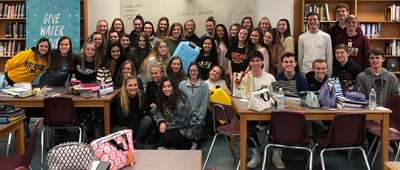Students at Patterson Mill Middle and High School in Bel Air, Maryland, received a visit from two young women who are traveling the country to educate young people about the global water crisis.
As part of their approximate 3,000-mile drive from Los Angeles, Hellen Elizondo and Anne Pfaff stopped by the Harford County school on February 22, 2019, as part of a “Road Warriors” program by the nonprofit Thirst Project, the world’s largest youth-led water activism organization.
“Currently there are over 663 million people living without access to clean drinking water and we are working to help fight against that,” Elizondo said.
The movement hopes to raise funds to build freshwater wells in developing nations and impoverished communities to provide as safe, clean and potable water as possible, Pfaff said.
“One well can provide up to 500 people with clean water indefinitely and save lives,” said Pfaff, who at just 19, said she first got involved in activism as a fighter for feminism and women’s empowerment.
“Then, I learned that some women and children— ages eight to 13— have to walk up to eight hours each day to collect contaminated water,” Pfaff said. “Women can’t contribute to the household because of this and children can’t get an education. I learned the way water attacks everything like food security and every single sector and that affected me.”
The Thirst Project has realized some success. The organization reports that over the past decade, they’ve raised about $10 million, which has allowed them to provide 360,000 people access to clean, safe and potable water.
The group’s “Road Warriors” [college activists] have visited 13 countries and 45 states educating more than 500,000 students about the water crisis and they’ve started over 200 Thirst Project School Clubs where participants come up with their own ideas to help stem the water crisis.
“The thing is, the [clean] water already exists in aquifers that are usually [buried] up to 300 feet underground,” Elizondo said.
Dirty and diseased water is the number one killer of children, globally, according to Project officials who note that when clean water is brought into a community, disease drops by upwards of 88 percent overnight and child mortality drops by nearly 99 percent.
During the “Road Warriors” trip around the country, Elizondo and Pfaff are teaching students about the scarcity of clean water in some parts of the world, such as places in Africa.
“Just talking about it and raising awareness is so key to solving this issue,” Pfaff said. “And 50 cents gives one person clean water for a year.”
Also, educating students around the country has led to positive action on the part of many, according to Elizondo.
“The students are so encouraged not only to spread the word but to do fundraisers,” Elizondo said. “Some of the kids will do fishing tournaments and other things and it’s so insane what they come up with and we couldn’t ask for anything more.”
For more information about the Thirst Project or to make a donation, visit https://www.thirstproject.org/
